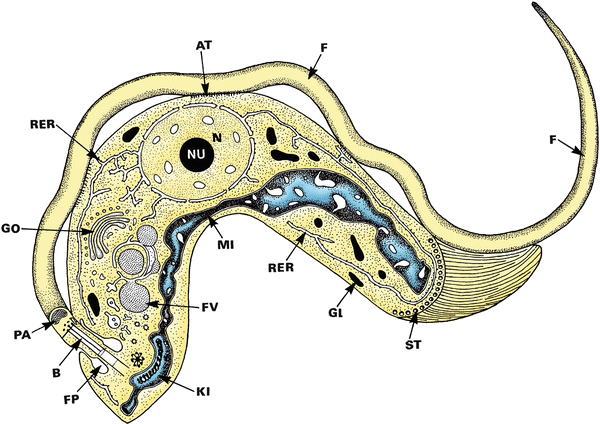Sub genus : Trypanozoon
Trypanosoma bruce
Location and host
- These parasites are found in blood of cattle, sheep, goat, horse, donkey, camel, pig, dog and cat.
- Vector of this parasite : Tabanus , Stomoxys.
Morphology
- Pleomorphic in form and ranges from long and selender upto 42 µm to short and stumpy; 12-26 µm.
- Undulating membrane is conspicuous
- Kinetoplast is small and sub terminal
- Posterior end is pointed
- In slender form, kinetoplast is upto 4 µm from posterior end, usually drawn out, tapering to points and had well developed free flagellum.
- In stumpy form, flagellum is either short or absent. Posterior end is broad and rounded with kinetoplast almost terminal.
- Intermediate form has blunt posterior end and moderately long flagellum.
- In fresh unmixed blood films, organism move rapidly within small areas of microscopic field.

Life cycle
- Tse-tse flies ingest trypanosomes in blood or lymph while feeding on an infected host.
- Trypanosomes lose their glycoprotein surface coat, becomes elongated and multiply in mid gut before migrating to salivary glands.
- There, they undergo transformation, loosing trypanomastigote form and acquire epimastigote form
- After further multiplication of epimastigote, they transform again into small typically trypomastigote form with glycoprotein surface coat. These are called metacyclic trypanosomes and are infective for next host.
- Metacyclic trypanosomes are inoculated into skin when vector feeds on host.
- At site of inoculation, metacyclic forms multiply locally as typical blood forms, producing a raised cutaneous inflammatory swelling called ‘chancre’.
- They enter blood stream and multiply resulting in parasitemia. These are detachable in peripheral blood.

Transmission
- Transmission is mainly through bite of vector flies
- Some flies may be transmitted through contact
Pathogenesis/ Clinical signs
- Disease is usually more chronic in cattle. Animal survive for several months and may recover.
- In cattle, major clinical signs are anemia, generalized enlargement of superficial lymph nodes, lethargy and progressive loss of body condition
- Intermittent fever and loss of appetite
- Pregnant animals may abort or give birth to weak offsprings
- In terminal stage, animals become extremely weak, lymph nodes reduced in size and there is often a jugular pulse.
Diagnosis
- Clinical signs, though indicative but not pathognomonic.
- Confirmatory diagnosis is through demonstration of trypanosomes in blood
- Serological test such as indirect fluorescent Ab test and ELISA.
Treatment and control
- Isometamidium @ 0.25-1 mg /kg intramuscular and diminazene aceturate @ 3-10 mg/kg intramuscular are drug of choice. Quinapyramine sulphate @ 3-5 mg/kg intramuscular only in horse
- Use of fly repellant and insecticide Suramin @ 7-10 mg/kg I/M or I/V in horse and camel
- Control of breeding of insect vectors